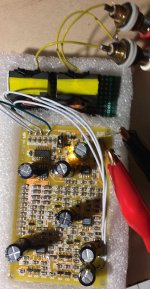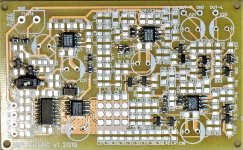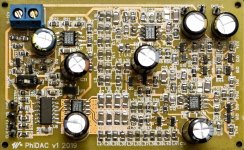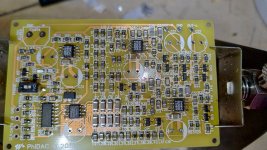Hi All,
A while back a kind gentleman (Matt Garman) sent me one of Richards PHIDac kits. After much torture soldering ant sized SMD components I think that I'm ready to power it up and give it a try. At first I'm going to try feeding it I2S from an old ministreamer that I have. I do have one question about the output. It is single ended leaving the board, but in some pictures that were posted it looks like the output from the DAC board is put through some output transformers. See the first pic, The other two pic are of my build. Do I need output transformers. Appreciate any help.
Paul
A while back a kind gentleman (Matt Garman) sent me one of Richards PHIDac kits. After much torture soldering ant sized SMD components I think that I'm ready to power it up and give it a try. At first I'm going to try feeding it I2S from an old ministreamer that I have. I do have one question about the output. It is single ended leaving the board, but in some pictures that were posted it looks like the output from the DAC board is put through some output transformers. See the first pic, The other two pic are of my build. Do I need output transformers. Appreciate any help.
Paul
Attachments
Hi,
I am watching this thread, so I think I can answer some questions.
If you have AD8017 opamps, your kit is probably rev.1. The relevant shematics are posted here: lingDAC - cost effective RBCD multibit DAC design
Pictures you posted have these opamps. It is not SE version.
The newer kit for version SE (as a title suggests) probably do not exist. However if you have AD815 opamps, you have version SE and your schematics are posted here: lingDAC - cost effective RBCD multibit DAC design
In both cases the output is single ended. Experiments with transformers it is a matter of further improvements. If you didn't receive transformers, connect single ended as on the schematics. Hope it helps.
I am watching this thread, so I think I can answer some questions.
If you have AD8017 opamps, your kit is probably rev.1. The relevant shematics are posted here: lingDAC - cost effective RBCD multibit DAC design
Pictures you posted have these opamps. It is not SE version.
The newer kit for version SE (as a title suggests) probably do not exist. However if you have AD815 opamps, you have version SE and your schematics are posted here: lingDAC - cost effective RBCD multibit DAC design
In both cases the output is single ended. Experiments with transformers it is a matter of further improvements. If you didn't receive transformers, connect single ended as on the schematics. Hope it helps.
Last edited:
@PJN - no, you don't need output transformers. They do come in useful if your I2S source is very noisy (such as a PC) but they're not essential. @sajunky is right, this is the original PhiDAC, not the 'SE' variant. No kits so far exist for the 'SE' as I've not seen much interest - if that were to change I'd consider creating kits.
Thanks for sharing your pics @PJN - looks to me that one or two components might not be soldered on both sides. Have a check on R47 and L1. I often make this mistake, forgetting to go back and finish a component.
Thanks for sharing your pics @PJN - looks to me that one or two components might not be soldered on both sides. Have a check on R47 and L1. I often make this mistake, forgetting to go back and finish a component.
Thanks Richard, I'll double check things out again. I found the smd soldering tough, had to do it in several sessions just to get through it. Crossing my fingers that it works.
The first picture looks very familiar. Its the one Abraxalito (Richard) sent me for review. Its still in the foam shipping tray exactly as you see it in the pic.
Interesting little dac, it does a great job of reproducing low level reverb tails, something SD dacs I have tried don't usually seem to be all that good at. The little dac sounded better with some film caps on the power rails, it turned out.
Richard included the transformers to make it more likely the dac would sound its best, IIRC. Common reasoning for that is because most reproduction systems with multiple components that plug together have some ground loop problems that degrade sound quality. IME, that's true even if something like a phono system with no computer. The symptoms aren't always hum and noise. Sometimes it much more insidious, the sound is more distorted in a way that can make a really good dac sound rather mediocre, but nothing in particular about the sound to suggest there is a ground-related problem going on.
Of course, in an unusually clean system in which the ground problems have somehow been cleaned up, there is virtually always some audible transformer distortion if one is used. When playing music the distortion appears as IMD, which is pretty much always at a higher level than the associated (resulting from the same non-linearity) harmonic distortion would be.
Still, if it sounds better using a little line isolation transformer then probably good to have it there.
Interesting little dac, it does a great job of reproducing low level reverb tails, something SD dacs I have tried don't usually seem to be all that good at. The little dac sounded better with some film caps on the power rails, it turned out.
Richard included the transformers to make it more likely the dac would sound its best, IIRC. Common reasoning for that is because most reproduction systems with multiple components that plug together have some ground loop problems that degrade sound quality. IME, that's true even if something like a phono system with no computer. The symptoms aren't always hum and noise. Sometimes it much more insidious, the sound is more distorted in a way that can make a really good dac sound rather mediocre, but nothing in particular about the sound to suggest there is a ground-related problem going on.
Of course, in an unusually clean system in which the ground problems have somehow been cleaned up, there is virtually always some audible transformer distortion if one is used. When playing music the distortion appears as IMD, which is pretty much always at a higher level than the associated (resulting from the same non-linearity) harmonic distortion would be.
Still, if it sounds better using a little line isolation transformer then probably good to have it there.
Last edited:
OK I've double checked the board again everything looks ok under magnification, I resoldered the two issues that Richard mentioned. Before I power things up I have a couple more questions. To do my initial test I'm going to piggyback it to use parts from an older DAC that I put together a few years ago, a Curryman DAC.
I'm using a WM8804 receiver board from Twisted Pear to feed the PHIDAC but the nomenclature on the output differs somewhat from the inputs on the PHI. The WM8804 outputs BCK, SCK, LRCK, Dout, Gnd, and Din. The PHI inputs CLK, Data, WS, and Gnd. So far I've hooked it up like this, BCK >CLK, Dout>Data, LRCK>WS, and Gnd>Gnd. Does this seem correct ?
Also the PHI calls for 9 - 12 vdc, but the PSU in the curryman dac puts out 14.5 vdc. It would be very convenient to use this PSU if the higher voltage wouldn't toast the board. Is this OK ? If not I'll put together another PSU.
Thanks,
Paul
I'm using a WM8804 receiver board from Twisted Pear to feed the PHIDAC but the nomenclature on the output differs somewhat from the inputs on the PHI. The WM8804 outputs BCK, SCK, LRCK, Dout, Gnd, and Din. The PHI inputs CLK, Data, WS, and Gnd. So far I've hooked it up like this, BCK >CLK, Dout>Data, LRCK>WS, and Gnd>Gnd. Does this seem correct ?
Also the PHI calls for 9 - 12 vdc, but the PSU in the curryman dac puts out 14.5 vdc. It would be very convenient to use this PSU if the higher voltage wouldn't toast the board. Is this OK ? If not I'll put together another PSU.
Thanks,
Paul
you should be good to go, see I²S detailsThe WM8804 outputs BCK, SCK, LRCK, Dout, Gnd, and Din. The PHI inputs CLK, Data, WS, and Gnd. So far I've hooked it up like this, BCK >CLK, Dout>Data, LRCK>WS, and Gnd>Gnd. Does this seem correct ?
Use another PSU. AD8017 absolute maximum voltage is only 13V.Also the PHI calls for 9 - 12 vdc, but the PSU in the curryman dac puts out 14.5 vdc. It would be very convenient to use this PSU if the higher voltage wouldn't toast the board. Is this OK ? If not I'll put together another PSU.
Last edited:
I'm using a WM8804 receiver board from Twisted Pear to feed the PHIDAC but the nomenclature on the output differs somewhat from the inputs on the PHI. The WM8804 outputs BCK, SCK, LRCK, Dout, Gnd, and Din. The PHI inputs CLK, Data, WS, and Gnd. So far I've hooked it up like this, BCK >CLK, Dout>Data, LRCK>WS, and Gnd>Gnd. Does this seem correct ?
Yes, as confirmed.
Also the PHI calls for 9 - 12 vdc, but the PSU in the curryman dac puts out 14.5 vdc. It would be very convenient to use this PSU if the higher voltage wouldn't toast the board. Is this OK ? If not I'll put together another PSU.
As sajunky points out, 14.5V is too high. If you have some standard 1A diodes to hand (for example 1N4002) you could use 4 in series to drop the output of this supply to around 12V.
PhiDAC built
Very kind guy Matt had sent all PhiDAC parts to mee last year as well. Thanks again Matt! Due to some unexpected sparetime I went on to build this DAC. What a pain! Never seen a DIY project with that many parts per area. Fantastic layout but really exhausting for an old man. Good to have hot air equipment for that and a magnifier lamp. It took me four to five hours of work spread over some days. Had to pause always after an hour or so. Except the lytics it is done and will be finished soon and i am really courious about its sound.
Will have a pic soon for you.
Cheers, Ernst
Very kind guy Matt had sent all PhiDAC parts to mee last year as well. Thanks again Matt! Due to some unexpected sparetime I went on to build this DAC. What a pain! Never seen a DIY project with that many parts per area. Fantastic layout but really exhausting for an old man. Good to have hot air equipment for that and a magnifier lamp. It took me four to five hours of work spread over some days. Had to pause always after an hour or so. Except the lytics it is done and will be finished soon and i am really courious about its sound.
Will have a pic soon for you.
Cheers, Ernst
- Home
- Source & Line
- Digital Line Level
- PHIDac SE build and questions



